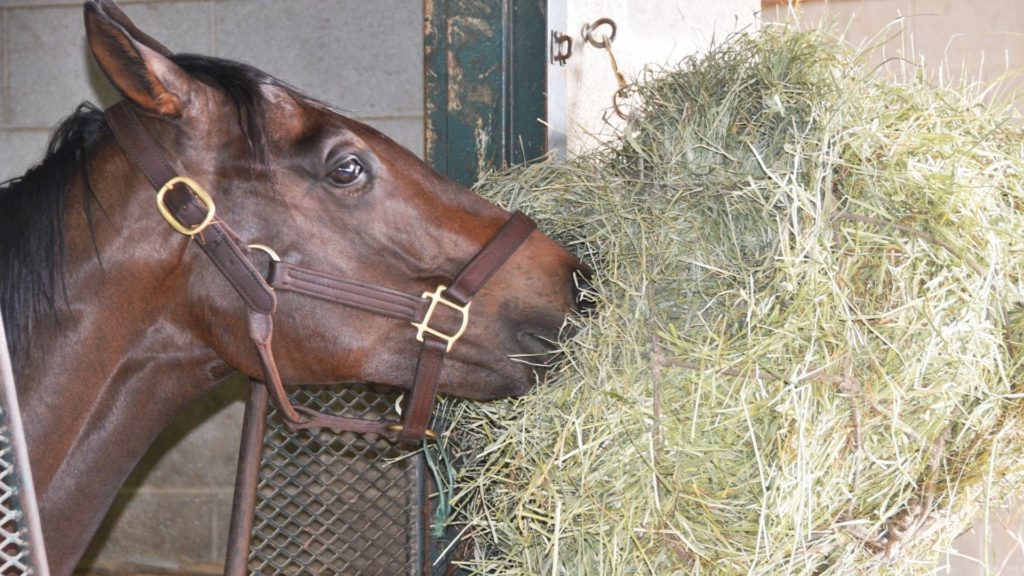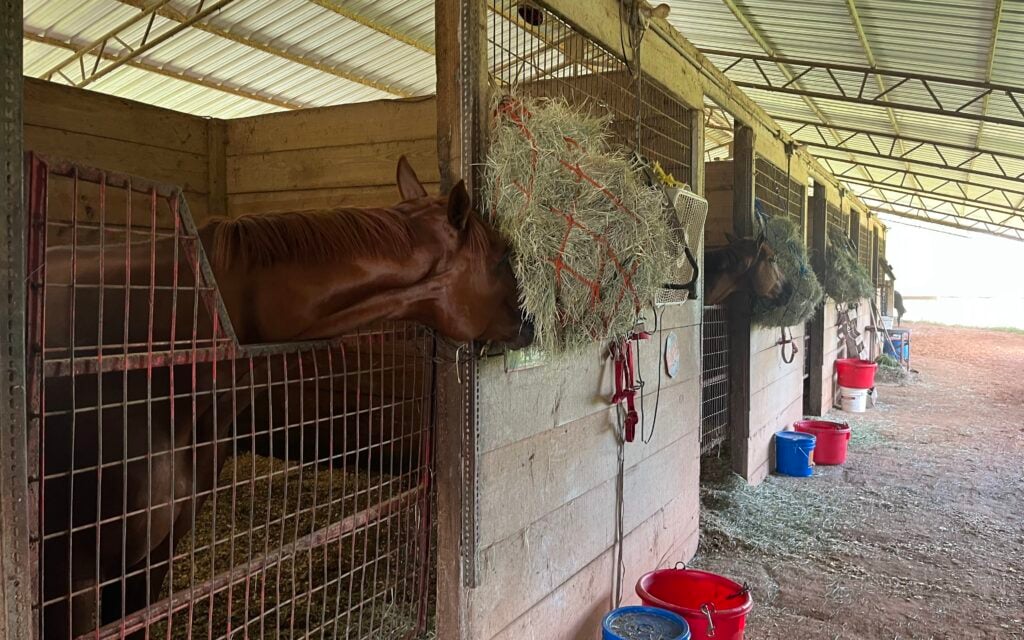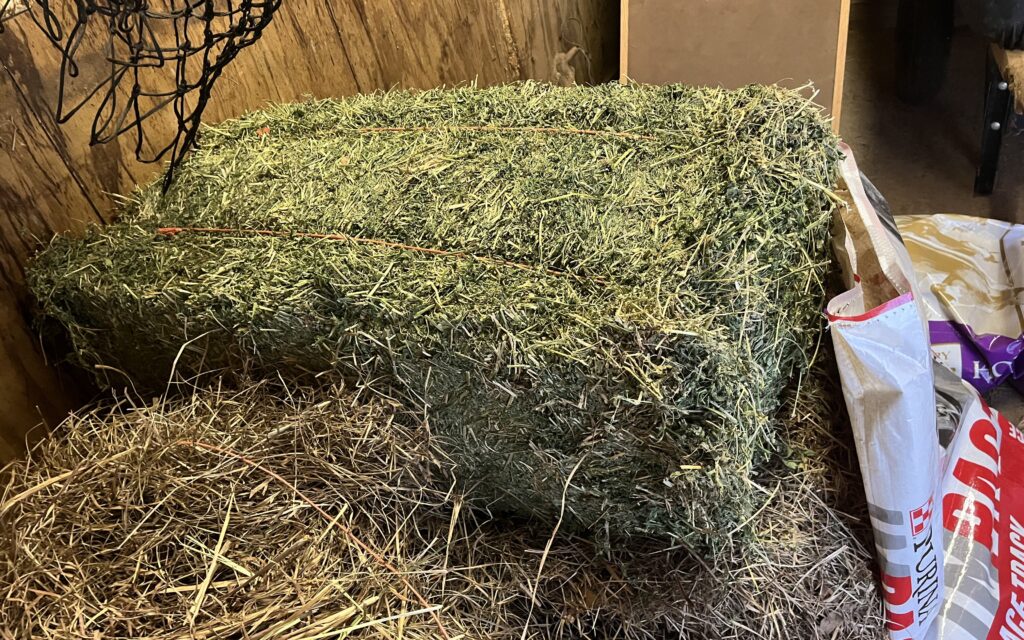Last updated: August 24, 2023
We supply our horses with a lot of hay, and sometimes I get asked how I decide the correct amount to feed each one. If you’re a horse owner, you know hay is an important part of your horse’s diet. But are you aware of how much hay a horse needs to eat per day?
The average horse needs to eat between 1 and 2% of its body weight in hay per day. For a 1000-pound (450kg) horse, that’s 10-20 pounds (4.5-9kg) of hay per day. Of course, this depends on the type of hay, the horse’s activity level, and other factors.
Many horse owners are curious about the recommended hay intake for their horses. This blog post will discuss horses’ daily hay requirements and tips on feeding and storing hay. So, keep reading to learn more.
How Much Hay Does a Horse Need to Eat Per Day?
The amount of horse your horse needs to eat per day depends on a number of factors, including the age, breed, and activity level of your horse. For example, a pregnant mare or a young foal will need more hay than an adult horse who isn’t working very hard.
And a horse who is working hard will need more hay than a retired horse who isn’t doing much exercise. The quality of the hay is also important. Higher-quality hay will have more nutrients, so your horse will need to eat less of it.

But as a general rule of thumb, most horses need between 1% and 2% of their body weight in hay per day. Let’s say, for example, that you have a 1,000-pound horse. This means that your horse should eat between 10 and 20 pounds of hay daily.
We have six horses in different levels of training. We typically feed them twice a day for a total of two percent of the weight in hay, and we feed the hay in hay bags to slow their eating and reduce boredom.
Of course, hay is just one part of a horse’s diet. Horses also need access to fresh water and a balanced diet of grains and other nutrients. So, in addition to the hay, we give our horses one scoop of grain in the morning and evenings.
But if you’re wondering how much hay your horse needs to eat each day, the answer is somewhere between 1% and 2% of his body weight. If you’re unsure how much your horse weighs, you can do some simple calculations with a measuring tape to get a general idea.
You can also ask your veterinarian for a recommendation. They can help you figure out how much hay your horse should eat based on age, weight, activity level, and health condition.
You can also find guidelines from equine organizations like the American Association of Equine Practitioners (AAEP). Once you know how much hay your horse needs, you can adjust the amount up or down based on how they look and feel.
If your horse starts losing weight or looking unhealthy, increase the amount of hay they’re eating. If they start gaining too much weight or you lower the amount of exercise they’re getting, then decrease the amount of hay you’re feeding.

How do you go about choosing the right type of hay for your horse?
If you’re a horse owner, you know that hay is an important part of your horse’s diet, it provides essential nutrients like fiber, protein, and minerals, and it should make up the majority of your horse’s daily intake.
But with so many different types of hay on the market, how do you know which one is right for your horse? Here are a few tips on how to choose the right hay for your horse.
First, you need to think about the type of hay. There are three main types of hay: legumes, grasses, and mixed. Legumes like alfalfa are high in protein and calcium, making them ideal for young horses or pregnant or nursing horses.
I find that a mix of bermudagrass and Alfalfa hay works well for our horses. Straight Alfalfa is too rich and causes some horses to have digestive issues. Whereas bermudagrass alone doesn’t provide enough protein for working horses. For our horses, a mixture of three parts Alfalfa and one part bermudagrass works best.
Grasses like Timothy hay are lower in calories and better suited for adult horses that are lower in activity. Mixed hay is just that – a mix of legumes and grasses – and can be a good option for horses of all ages.
Another thing to consider is the quality of the hay. You want to look for green hay with a fresh smell. Avoid hay that is brown or has mold on it. And check the texture of the hay. You want to avoid any dusty or moldy hay, as this could cause respiratory problems for your horse.
We currently have one horse with heaves, which we think was caused because he ate dusty hay. It has set him back on his training and caused him a lot of distress. Our vet is scheduled to visit us today.
Also, be sure to check to make sure the hay was harvested at the proper time. Hay that was harvested too early or too late may not have all the nutrients your horse needs. In our region, we are able to buy hay directly from the local farmers and often pick up our hay in the fields.

The Importance of Hay in a Horse’s Diet
Horses are natural grazers, which means that they’re designed to eat small meals throughout the day. In the wild, horses graze for sixteen hours or more, taking in small amounts of forage as they go.
Unfortunately, most modern horses are stabled and don’t have access to fresh grass. As a result, they need to rely on us to provide hay for their daily intake of nutrients.
The horses we have in training get out of their stalls daily and graze for an hour or so, but we also provide them an ample supply of alfalfa and bermudagrass hay daily to meet their forage requirements.
Ensuring your horse has hay is important for a number of reasons. First, it provides horses with the fiber they need to stay healthy. Hay is also a good source of calories, which is important for horses that are working hard or growing rapidly. A diet rich in hay can help prevent colic.

Tips for storing hay for your horses
Did you know that how you store your hay can affect your horse’s health? Here are a few tips to help you store hay so that it stays fresh and nutritious for your horse.
1. Make sure the hay is dry before storing it. If the hay is too wet, it will mold and become unusable.
2. Store the hay in a cool, dry place. A temperature-controlled environment is ideal, but a cool shed or garage will work as well.
3. Keep the hay off the ground by storing it on racks or on pallets. This will help keep pests away from the hay and prevent it from getting dirty.
4. Inspect the hay regularly for signs of mold or spoilage. If any of the hay is bad, remove it from the storage area so it doesn’t contaminate the rest of the batch.
5. Stored hay can lose some of its nutrients over time, so it’s important to rotate through your supply so that your horse always has access to fresh, healthy hay. Feed your horse fresh hay regularly to ensure that they’re getting the nutrition they need.
By following these simple tips, you can be sure that your horse always has access to fresh, nutritious hay. Storing hay doesn’t have to be complicated – just be sure to keep it dry, cool, and off the ground, and inspect it regularly for signs of spoilage. By taking these steps, you can rest assured that your horse is getting the best possible nutrition.

Tips for feeding hay to your horses
Hay is an important part of a horse’s diet, providing them with the fiber they need to stay healthy. However, feeding hay to your horse can be a bit of a challenge. Here are a few tips to help you make sure your horse is getting the nutrition they need from its hay.
How Often Should You Feed Hay to Your Horse?
You should feed hay to your horse at least twice a day, and more if possible. If you’re only feeding hay once a day, your horse may still get the correct amount of hay, but its digestive system works better when its forage intake is spread out.
If your horse is overweight, you may not need to reduce the amount of hay you feed it but rather change the type of hay. Some hays have more sugar and fat than others. Timothy hay is recommended for overweight horses because it is nutritious yet low in sugar and calories.
Feeding three times a day would be even better than feeding your horse twice a day; however, for many people, this is impractical. When feeding hay, it’s important to pay attention to how much your horse is eating. A good rule of thumb is that a full-sized horse should eat about 10-15 pounds of hay per day.

What Are the Benefits of Using Slow Feeders?
Slow feeders, such as hay nets and hay racks, are a great way to make ensure your horse doesn’t gobble down its hay ration too quickly. Hay nets, racks, and bags help slow the eating process, allowing horses to better digest their food and extract more nutrients.
Additionally, slow feeders can help prevent horses from getting bored or anxious when eating, as they provide a more natural eating experience. Most often, we use a hay net for feeding hay to our horses.
You can find them with various size openings. The smaller the holes, the less hay the horse can extract at a time. I find hay nets easy to use and effective.
Feeding hay to your horse can be challenging, but it’s important to ensure they’re getting the nutrition they need. By following these tips, you can ensure that your horse is healthy and happy.

Conclusion:
Hay is an important part of your horse’s diet, but how much should they be eating? The answer may surprise you. The average horse must eat between 1 and 2% of its body weight in hay daily.
Of course, this number depends on factors like the type of hay, the horse’s activity level, and other factors. To figure out how much hay your horse needs, start by asking your veterinarian for a recommendation.
Below is a YouTube video that discusses how much hay a horse needs to eat a day.
FAQs
How much hay should a 1000-pound horse eat a day?
A mature 1,000-pound horse should eat 15 to 20 pounds of hay per day on average; if you’re working your horse or giving it grain, the amount of hay it needs will vary.
What happens when horses eat too much hay?
If a horse eats too much rich hay, especially in the form of alfalfa, it can cause laminitis, diarrhea, and possibly even colic. However, most horses do best when they have free access to grass hay.

About the Author: Miles Henry
Lifelong Horseman | Racehorse Owner | Published Author
Miles Henry brings over 25 years of hands-on experience training and owning Thoroughbred racehorses. Raised with Quarter Horses and Appaloosas, he’s spent a lifetime learning from horses—on the track, in the barn, and in the field. Today, he runs a small but successful racing stable in Louisiana and shares real-world insights on HorseRacingSense.com, helping horse owners, fans, and bettors navigate the sport with confidence.
📚 Books: View Miles’s books on Amazon »
🎧 Podcast Guest: Animal Tales Ep. 32 |
YouTube Interview
📩 Newsletter: Sign up for racing tips and horse care advice »
🔗 Follow Miles:
Twitter |
Facebook |
YouTube


